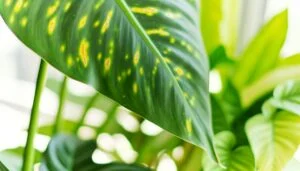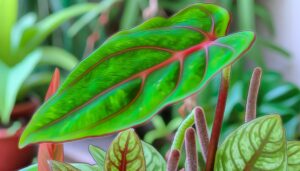Why Is My Pink Princess Philodendron Drooping?
Drooping in a Pink Princess Philodendron can arise from various factors. Overwatering is a primary cause, leading to root oxygen deprivation and rot.
Conversely, underwatering reduces turgor pressure. Inadequate light diminishes leaf vitality, while temperature extremes disrupt cellular processes.
Maintaining an ideal humidity range (60-80%) supports physiological health. Poor soil quality affects nutrient uptake and root aeration.
Pests, diseases, and root bound conditions further stress the plant, causing wilt. Nutrient deficiencies, particularly in nitrogen, iron, and magnesium, also contribute to drooping.
Addressing these conditions will help restore your plant's health. For essential solutions, explore the discussed factors in more detail.
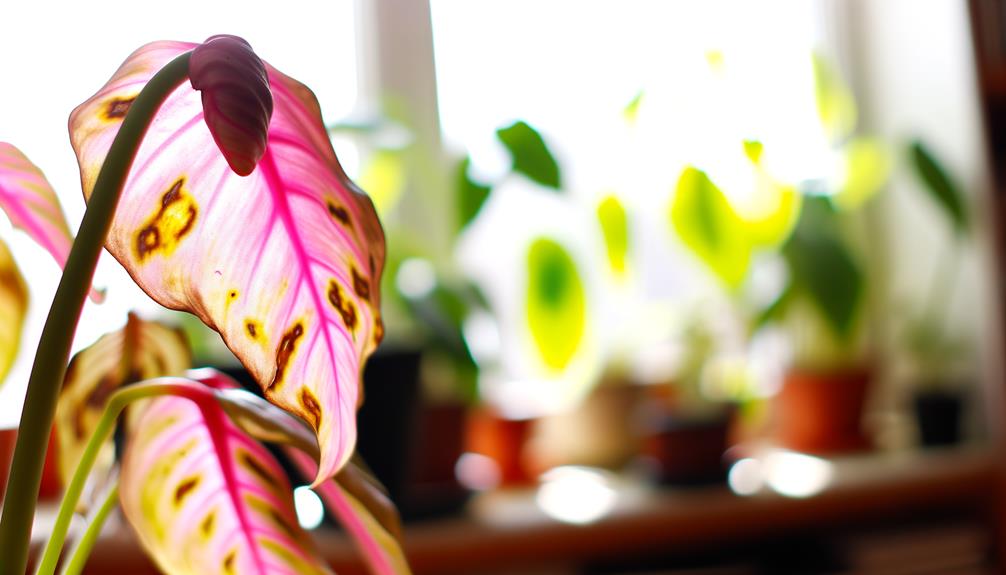
Key Takeaways
- Overwatering can lead to root oxygen deprivation and root rot, causing drooping.
- Underwatering reduces turgor pressure, leading to drooping leaves.
- Inadequate light intensity results in sparse and droopy leaves.
- Temperature extremes outside the 65-80°F range can disrupt cellular processes and cause wilting.
- Pests and diseases, such as spider mites and root rot, can stress the plant and cause drooping.
Overwatering Issues
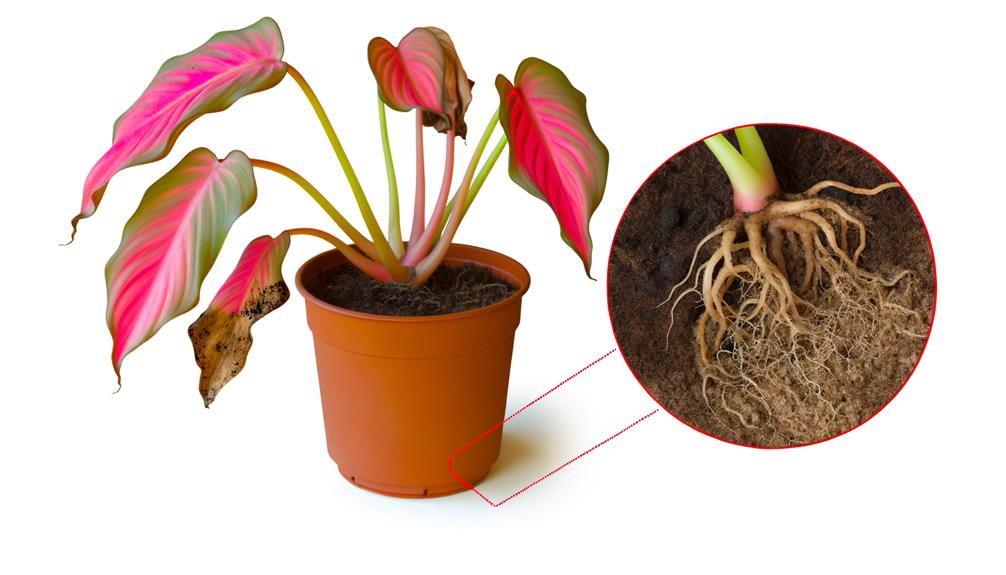
Overwatering is a primary cause of drooping in Pink Princess Philodendrons, as it leads to root oxygen deprivation and subsequent root rot.
When the substrate remains excessively damp, it disrupts the plant's ability to uptake oxygen through its root system, resulting in hypoxic conditions. This anaerobic environment fosters pathogenic fungi and bacteria, which attack the roots, compromising their structural integrity and functionality.
As a consequence, the plant's vascular system becomes impaired, inhibiting the efficient transport of water and nutrients to aerial parts. Research indicates that early symptoms include leaf yellowing and wilting, which precede the drooping phenomenon.
It is crucial to employ a well-draining soil mix and adhere to a balanced watering regimen to mitigate overwatering-related stress and maintain peak plant health.
Underwatering Concerns
Underwatering can greatly impact the Pink Princess Philodendron, leading to reduced turgor pressure and subsequent drooping. Evaluating soil moisture levels is vital, as insufficient hydration impairs the plant's physiological processes, especially water transport and nutrient uptake.
Regular monitoring and adjusting watering frequency based on environmental conditions can alleviate these negative effects.
Soil Moisture Levels
Inadequate soil moisture levels can lead to physiological stress in Pink Princess Philodendrons, manifesting as drooping foliage due to insufficient water uptake. This condition often arises when the moisture content in the soil falls below ideal levels, impairing the plant's ability to maintain turgor pressure in its cells. Research indicates that maintaining consistent soil moisture is crucial for the plant's overall hydration status and metabolic functions. Insufficient moisture can disrupt the plant's nutrient transport mechanisms, leading to impaired photosynthesis and growth.
| Symptom | Cause |
|---|---|
| Drooping leaves | Low soil moisture |
| Yellowing | Inconsistent watering |
| Wilting | Prolonged dehydration |
Ensuring that soil remains appropriately moist, but not waterlogged, is essential for the health of Pink Princess Philodendrons.
Watering Frequency
Consistent watering practices are fundamentally important to prevent insufficient watering, which can worsen drooping in Pink Princess Philodendrons by disrupting the plant's water and nutrient uptake mechanisms. Proper hydration ensures optimal cellular pressure, maintaining structural integrity and physiological function. Research indicates that irregular watering can lead to root desiccation, impairing the philodendron's ability to absorb necessary minerals.
It is advisable to maintain a watering schedule that aligns with the plant's growth cycle and environmental conditions. By doing so, you can minimize risks associated with water stress. Ideally, the soil should remain consistently moist but not waterlogged, as overcompensation for insufficient watering could lead to root rot. Monitoring soil moisture levels can aid in achieving this balance.
Light Intensity
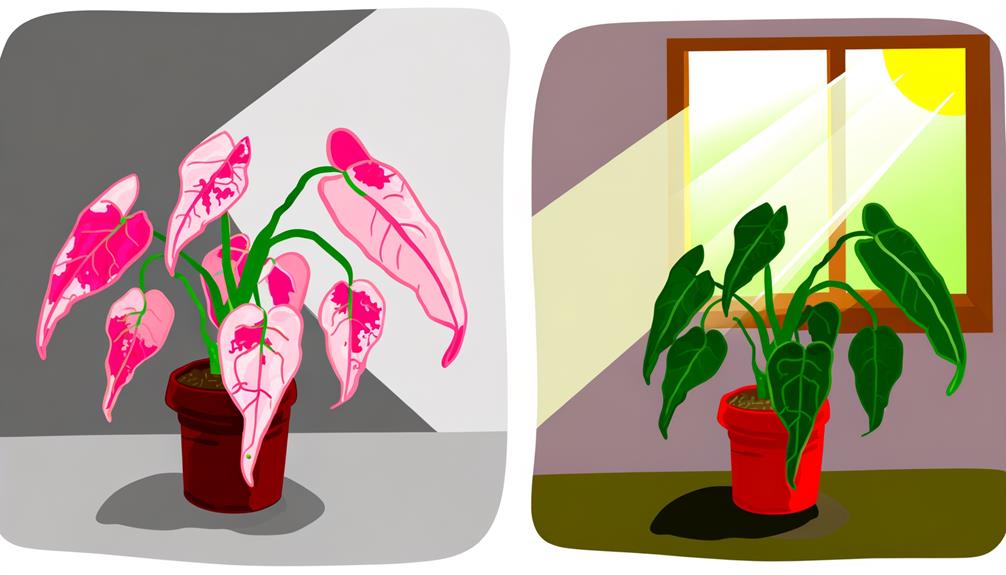
Ideal light intensity is crucial for maintaining the turgor pressure and overall health of the Pink Princess Philodendron. Inadequate light can lead to etiolation, where stems elongate, and leaves become sparse and droopy. Conversely, excessive light results in photoinhibition, causing leaf scorch and reduced photosynthetic efficiency.
Moderate Indirect Light: Optimum growth occurs under bright, indirect light, resembling understory forest conditions.
Photosynthetically Active Radiation (PAR): Sustaining a PAR range of 200-400 µmol/m²/s supports chlorophyll function.
Light Duration: Approximately 12-14 hours of consistent light exposure is ideal.
Light Source: Utilize full-spectrum grow lights in low natural light environments.
Leaf Orientation: Regularly rotate the plant to ensure uniform light distribution, preventing uneven growth and drooping.
Temperature Extremes
Temperature extremes can greatly influence the physiological health of the Pink Princess Philodendron, leading to drooping and other stress symptoms. Exposure to cold drafts disrupts cellular processes and impedes growth, while excessive heat induces transpiration imbalance and leaf wilting.
Maintaining an ideal temperature range of 65-80°F is essential for the best plant function and vitality.
Cold Drafts Impact Growth
Exposure to cold drafts can disrupt the metabolic processes in Pink Princess Philodendron, leading to impaired growth and physiological stress. These temperature fluctuations can cause cellular damage, hinder nutrient uptake, and impede photosynthetic efficiency.
Additionally, prolonged exposure to cold drafts can result in leaf chlorosis, wilting, and necrosis.
- Cellular Damage: Sudden temperature drops can cause cell membrane rigidity, leading to cellular injury and reduced function.
- Nutrient Uptake Hindrance: Lower temperatures may slow root metabolic activities, impairing nutrient absorption.
- Photosynthetic Inefficiency: Cold drafts reduce enzyme activity essential for photosynthesis, lowering the plant's energy production.
- Leaf Chlorosis: Inadequate nutrient uptake and low temperatures can lead to yellowing leaves, indicating chlorophyll degradation.
- Wilting and Necrosis: Extreme cold can cause irreversible tissue damage, leading to wilting and eventual cell death.
Heat Stress Symptoms
Prolonged periods of heightened temperatures can lead to heat stress in Pink Princess Philodendron. This stress manifests in symptoms such as leaf scorch, increased transpiration rates, and enzyme denaturation. Leaf scorch is characterized by browning and curling of leaf margins, occurring due to excessive water loss and cellular damage.
Increased transpiration rates, a plant's physiological mechanism to cool down, can worsen dehydration and nutrient imbalances. Enzyme denaturation, resulting from sustained high temperatures, disrupts metabolic processes essential for plant growth and development.
These physiological responses collectively impair the plant's ability to maintain homeostasis, ultimately contributing to drooping and reduced vigor. Understanding these symptoms is vital for diagnosing heat stress and implementing appropriate cultural practices to mitigate its impact.
Ideal Temperature Range
Maintaining a perfect temperature range is crucial for the physiological well-being of Pink Princess Philodendron, as temperatures consistently outside this range can trigger stress responses. Research indicates that these plants thrive in temperatures between 65°F to 80°F (18°C to 27°C).
Deviations from this range can lead to compromised cellular function, reduced photosynthetic efficiency, and increased vulnerability to pathogens.
Key considerations for temperature management include:
- Avoidance of temperature fluctuations: Sudden changes can trigger thermal shock.
- Consistent indoor climate control: Utilize thermostats to maintain stable temperatures.
- Shielding from direct heat sources: Proximity to radiators or direct sunlight can increase temperatures excessively.
- Monitoring ambient humidity: Proper humidity levels support temperature regulation.
- Seasonal adjustments: Adapt care practices to seasonal temperature variations.
Understanding these factors ensures peak plant health.
Humidity Levels
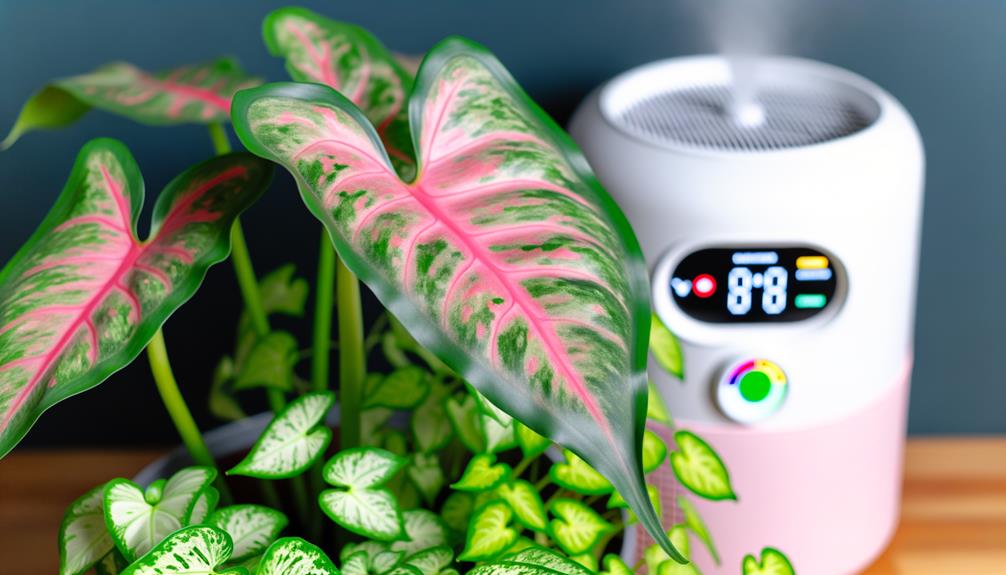
How does an environment's relative moisture impact the turgor pressure and overall health of a Pink Princess Philodendron?
High relative moisture environments enhance turgor pressure by facilitating best water uptake through osmosis, thereby maintaining cellular rigidity and structural integrity. Conversely, low moisture levels can lead to excessive transpiration, causing cellular water loss and subsequent turgor pressure reduction. This physiological response manifests as leaf wilting and drooping, indicative of stress.
Empirical studies highlight that maintaining moisture levels between 60-80% is essential for Pink Princess Philodendron health. Inadequate moisture can impair stomatal function, reducing photosynthetic efficiency and overall plant health. Therefore, maintaining appropriate moisture is crucial for preventing drooping and ensuring robust growth.
Soil Quality
Ideal soil quality is crucial for the Pink Princess Philodendron, as it directly influences nutrient uptake, root health, and overall plant health. The substrate must provide optimal aeration and drainage while retaining sufficient moisture. A well-draining mix prevents root rot, a common issue in waterlogged soils. Incorporating organic matter enhances the soil's nutrient-holding capacity and microbial activity.
Aeration: Maintains oxygen availability to roots, preventing hypoxia.
Drainage: Essential for avoiding waterlogged conditions and root rot.
pH Level: A slightly acidic to neutral pH (5.5-7.0) maximizes nutrient availability.
Organic Matter: Supports microbial life and enhances nutrient cycling.
Texture: A balance of coarse and fine particles facilitates both water retention and drainage.
These factors collectively contribute to the physiological well-being of the plant.
Pests and Diseases
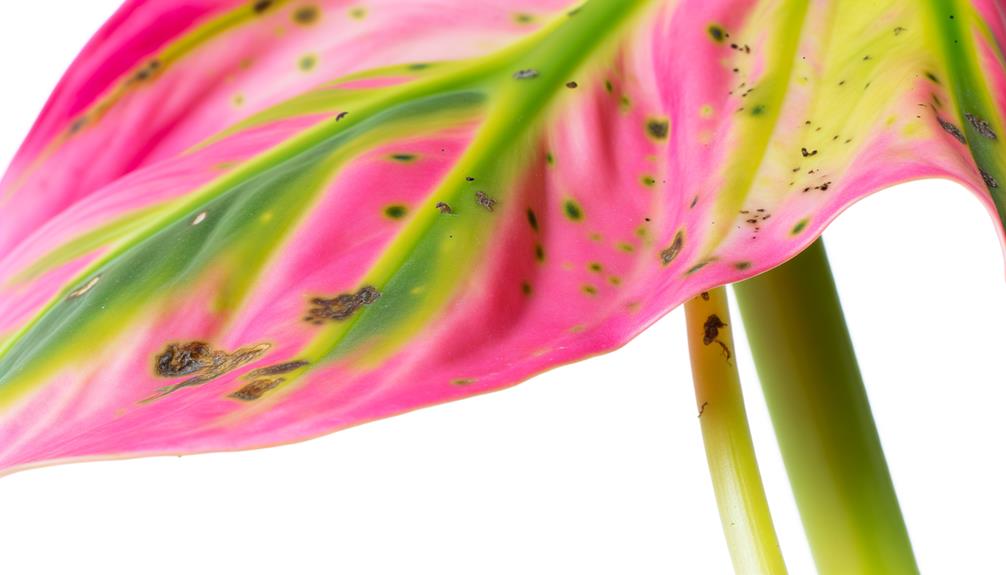
While best soil quality is necessary for plant health, the Pink Princess Philodendron is also susceptible to various pests and diseases that can greatly impact its growth and health. Common pests such as spider mites, aphids, and mealybugs can cause extensive damage by sucking plant sap, leading to chlorosis and drooping leaves. Diseases like bacterial leaf spot and root rot, often caused by overwatering or poor drainage, can further worsen plant stress.
| Pests | Symptoms |
|---|---|
| Spider Mites | Fine webbing, yellow speckling |
| Aphids | Sticky residue, curled leaves |
| Mealybugs | Cotton-like masses, weak growth |
Prompt identification and treatment are essential to prevent severe damage and maintain the plant's vigor.
Root Bound Problems
Root bound problems arise when the Pink Princess Philodendron's roots outgrow their container, leading to restricted nutrient uptake and stunted growth. This condition occurs when the root system becomes densely packed, inhibiting essential physiological processes such as water absorption and nutrient transport. Root bound symptoms present as yellowing leaves, reduced vigor, and drooping.
- Impaired root respiration: Compacted roots limit oxygen availability.
- Reduced nutrient uptake: Constricted roots impede the absorption of nutrients.
- Water stress: Dense roots hinder efficient water uptake, causing drought-like conditions.
- Physical root damage: Roots may become entangled and damaged, disrupting growth.
- Soil compaction: Overcrowded roots lead to less aerated soil, affecting root health.
Addressing root bound issues involves repotting into a larger container, ensuring optimal root expansion and overall plant well-being.
Nutrient Deficiencies
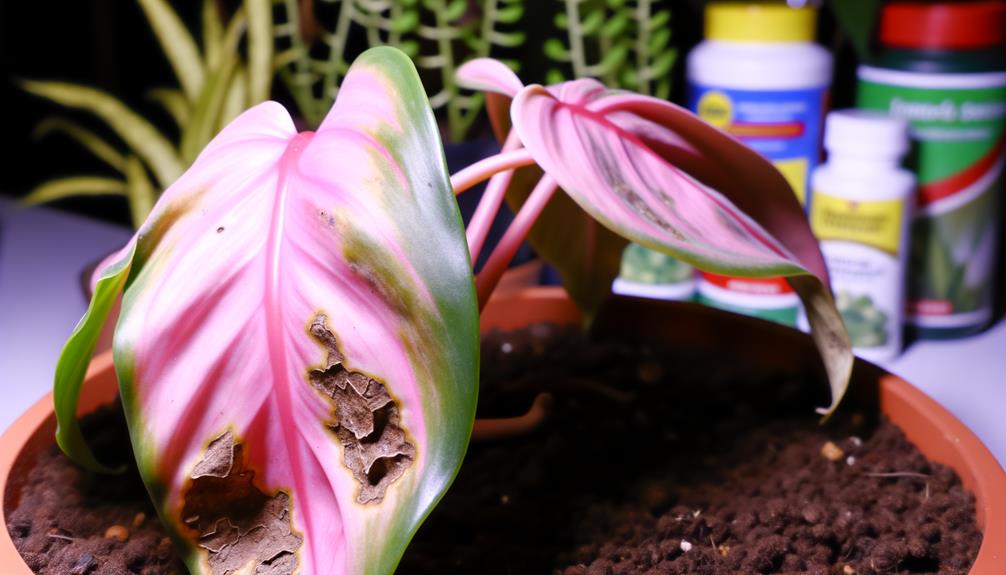
Nutrient deficiencies in Pink Princess Philodendron manifest as various physiological disorders, including chlorosis, necrosis, and stunted growth, due to insufficient essential mineral availability within the soil.
Chlorosis, characterized by yellowing leaves, typically indicates a lack of nitrogen, iron, or magnesium, essential for chlorophyll synthesis and cellular function.
Necrosis, involving tissue death, may result from potassium or calcium deficiencies, vital for cellular integrity and metabolic processes.
Stunted growth, often due to phosphorus or micronutrient shortages, impairs energy transfer and enzyme activation.
Regular soil testing and balanced fertilization are essential for maintaining ideal nutrient availability. Corrective measures may include applying chelated micronutrients or slow-release fertilizers to guarantee thorough nutrient uptake and sustained plant vigor.
Conclusion
The drooping of a Pink Princess Philodendron serves as a silent scream, indicating underlying physiological stress.
Whether a result of hydration imbalances, subpar light intensity, temperature fluctuations, insufficient humidity, poor soil quality, pestilence, or nutrient deficiencies, each factor disrupts balance.
Addressing these elements fosters the plant's importance, akin to fine-tuning a symphony to achieve perfect harmony.
Thorough understanding and intervention are crucial for restoring its strength and aesthetic beauty.



